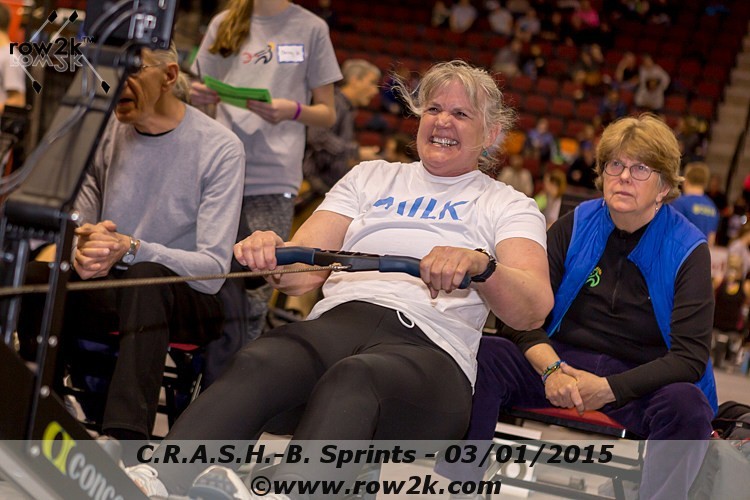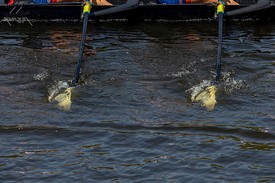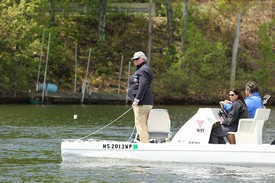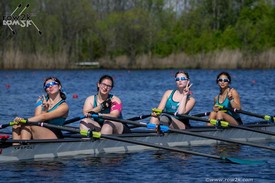Winning C.R.A.S.H.-B.'s since 1981

Carie Graves was at the very first C.R.A.S.H.-B. Sprints in the winter of 1981. It was the winter after the boycott of the 1980 Olympic Games, and the Model A erg – the one that was pretty much a bicycle wheel with a chain attached to a handle - was brand new. Graves, who was coaching at Radcliffe and training at the time, joined a group of folks on the second floor of Harvard's Newell Boathouse for that first race.
Just eight or so women were there that year, and Graves won the first hammer. Row2k caught up with Graves to hear about the beginnings of C.R.A.S.H.-B. and first years of the erg, getting back to training, and this years' race.
"I remember the first C.R.A.S.H.-B. quite well, because I have a picture that Bari Dreissigacker [wife of C2 cofounder Peter Dreissigacker] sent me," Graves said. "She's on one erg, I'm on the other erg, and Judy Geer is on the next erg. Judy hadn't married Dick [Dreissigacker, the other C2 brother] yet, but Bari was married to Pete – they all worked at Concept2."
The race that first year wasn't a 2k, it was five miles on a bicycle odometer – just over 8k - on the newfangled training machines. Though it was a new machine, the rowing community quickly adopted the erg; before its creation, the tools for testing athletes were limited.
"Prior to the Concept2 erg, [US Women's Head Coach] Kris Korzenowski travelled around the country testing rowers with a stationary bike that he checked onto every flight," Graves recalled.
The Model A erg's bicycle odometer measured distance, and during the first C.R.A.S.H.-B., someone with a stopwatch sat behind each of the rowers. When the odometer reached 5 miles, they hit the stopwatch and that was the recorded time. Technology has improved just a bit since then.
Despite the low numbers of women racing at the first C.R.A.S.H.-B., Graves remembers an atmosphere supportive of the women racing. All of the women rowing that day were training for the upcoming World Championships and '84 Olympics, which would be the third Olympic Games to include women's rowing (but only the second chance for the US team).
Since that first win, Graves has raked up many more C.R.A.S.H.-B. wins (among many other rowing accolades, including a gold medal at the '84 Olympics). She thinks there are 12 or 13 hammers in her collection, but this year's win was extra special because of the years she has taken off from the race. While she was coaching at the University of Texas, fatigue got the best of her, and for the past six years Graves has been away from the Sprints.
"When I retired, one of the things I wanted to do was stop feeling like such a slug and start exercising again," said Graves. "The best exercise I know of doing is erging. Last October I got an erg and started training on it…and it was really really disgustingly sucky because I was totally out of shape. I kept seeing these numbers that had 2's in front of them!
"Day after day after day it was so awful, but I didn’t stop. I never even saw numbers in the 1:50's at first."
Graves isn't the kind of person who gives up after a few bad training sessions (just read The Red Rose Crew, you'll understand), so she persisted. Come race day 2015, she was there in Agganis to turn "really really disgustingly sucky" into a C.R.A.S.H.-B. win, with a 7:40.6 – just three seconds off the 60-64 heavyweight women's world record.
With her old friend (and 1980 teammate) Holly Hatton coxing her, and former athletes she has coached in the stands, Graves had a supportive team cheering her on to the win.
"Holly has been my coxswain for years –she's very good and knows what she's doing. I'm used to her," said Graves.
"There were two ex rowers right in front of me in the stands; a woman who I coached at Northeastern with her ten year old son, and a woman who I coached at Texas. They didn't know each other before they both realized they had me as a coach. I was aware they were there, and they were very noisy and helpful."
Graves has seen women's rowing grow from absolutely nothing to a huge sport, both in the United States and around the globe. For her, watching world record breaker Sophia Asoumanaki pull a 6:30.2 was a huge testament to the growth of both rowing, and sport for women in general.
"This young woman [Asoumanaki] is something like 6'3" and she's embracing it because she has an opportunity to be an athlete," Graves said. "When I was in high school in rural Wisconsin and 6'1," I had no opportunities whatsoever - except ballet and figure skating - and needless to say no one was going to twirl me over their head."
The race went from just eight women racing in a boathouse to hundreds – of all ages, all abilities - racing on the floor of the Agganis Arena.
"This is the way it should be," she said.
If you enjoy and rely on row2k, we need your help to be able to keep doing all this. Though row2k sometimes looks like a big, outside-funded operation, it mainly runs on enthusiasm and grit. Help us keep it coming, thank you! Learn more.
- Bont Rowing
- Calm Waters Rowing
- Concept 2
- Craftsbury Sculling
- The Crew Classic
- CrewLAB
- Croker
- Dad Vail Regatta
- Durham Boat Co.
- Empacher
- Faster Masters
- Filippi
- Fluidesign
- h2row.net
- HUDSON
- Live2Row Studios
- Nielsen-Kellerman
- Oak Ridge RA
- Peinert Boat Works
- Pocock Racing Shells
- Race1 USA
- Rockland Rowing Masters Regatta
- RowKraft
- Rubini Jewelers
- Vespoli USA
- WinTech Racing
- Bont Rowing
- Calm Waters Rowing
- Concept 2
- Craftsbury Sculling
- The Crew Classic
- CrewLAB
- Croker
- Dad Vail Regatta
- Durham Boat Co.
- Empacher
- Faster Masters
- Filippi
- Fluidesign
- h2row.net
- HUDSON
- Live2Row Studios
- Nielsen-Kellerman
- Oak Ridge RA
- Peinert Boat Works
- Pocock Racing Shells
- Race1 USA
- Rockland Rowing Masters Regatta
- RowKraft
- Rubini Jewelers
- Vespoli USA
- WinTech Racing
















